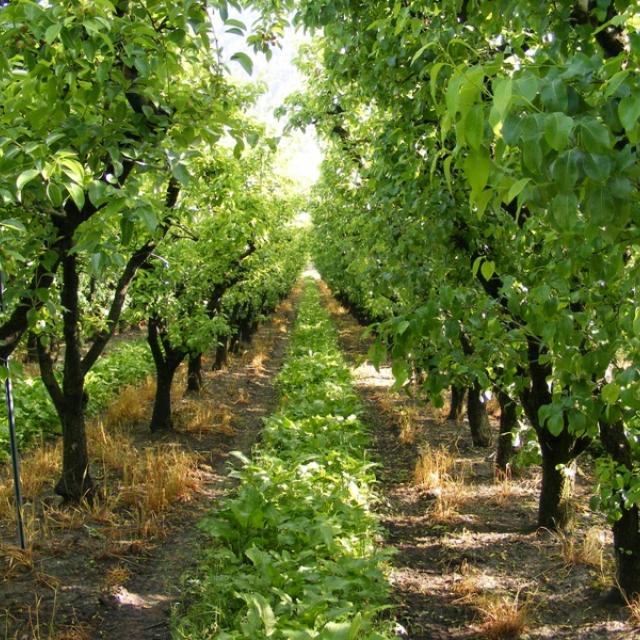For sprinkling below the tree canopy, it is possible to choose between different types of sprinklers. Water quality and planting type have an influence on the choice. The maintenance factor must not be forgotten either.

Below-canopy sprinkling has different advantages compared with overhead sprinkling: it avoids wetting the leaves and, therefore, it does not wash off the plant treatment products, nor does it leave stains on the fruit as a result of using hard water, and it also has a moderate flow-rate and pressure (lower than 30m3 or 3 bars respectively). Furthermore, it is easy to automate this type of equipment.
For below-canopy sprinkling, different types of sprinklers are available: the mini-diffuser sometimes called the micro-jet, the micro-sprinkler and the mini-sprinkler. “Basically, the choice is made according to the availability of the water resource, planting density and water quality”, says Isabelle Boyer, Ardepi’s irrigation advisor. The cost per hectare has changed very little in recent years: “It remains within a range of 1,900 to 2,700 euros/hectare, depending on the equipment chosen.”
Micro-jet, used instead of drip irrigation
The smallest of the microirrigation sprinklers, the micro-jet, is a form of localised microirrigation. The weaker the flow-rate of the micro-jets, the more sensitive they will be to clogging or blockage and thus the filtration system will have to be more efficient. Their use is not advisable when the water is polluted.
The micro-sprinkler, used in espalier-trained orchards
The micro-sprinkler is a medium-sized microirrigation sprinkler. In high density orchards, it enables the entire area to be watered and, therefore, a permanent grass surface can be maintained. It is less prone to blockage. And the micro-sprinkler allows for anti-frost measures to be taken.
Mini-sprinkler, used in low density plantations
Mini-sprinklers, also called mini-sprayers, have the greatest radius. They are suitable in medium- or low-density orchards and are unsuitable in plantations with close spacing: interception of the water jet by the tree trunks would prevent proper distribution.
Once the type of microirrigation sprinkler has been chosen, it is possible to compare the models available, but “tests show that, overall, a number of different brands are offering efficient microirrigation sprinklers”, the advisor notes. Certain sprinklers are of the “self-regulating” type: The flow-rate is regulated by a silicone membrane or additional regulator. They are more expensive, which is why they are only used in specific situations (longer field lengths, uneven ground, etc.).
All the microirrigation sprinklers are mounted on a spike in the ground or suspended from a stand, hanging down in the case of the micro-jet or the micro-sprinkler. Mounting the sprinklers on spikes poses a particular problem when working the soil in the orchard or plot, (mowing, soil maintenance, weed-control). There is a risk of the sprinklers becoming damaged by farm machinery, passers-by, etc. Insects or weeds can sometimes obstruct the orifice of the emitter. To overcome this, a sprinkler can have an insect protection cover or the grass and weeds can be cut along the row.
In conclusion, it is essential to ensure that the installation is well monitored and maintained, rather than just relying on buying the most efficient equipment. It is possible to have quality irrigation with simple equipment providing you monitor the installation properly. To find out more, refer to the “Fertile Water” fact sheet: Monitoring and maintaining a microirrigation installation.
|
DIFFERENCES IN PATTERN RADIUS AND FLOW-RATE Comparison of different types of microirrigation sprinklers used in below-canopy irrigation
|
||||
|
|
|
Micro-jet |
Micro-sprayer |
Mini-sprayer |
|
Type of mechanism |
Static with deflector or turbulent system |
Rotary vanes |
Rotary, gear-drive or impact models |
|
|
Flow-rate |
20 to 60 litres/hour |
35 to 150 litres/hour |
150 to 500 litres/hour |
|
|
Pressure |
1 to 2 bar |
1.5 to 2.5 bar |
2 to 3 bar |
|
|
Pattern Radius (throw) |
1 to 2 m |
2 to 4 m |
5 to 8 m |
|
|
Filtration is compulsory |
Clear water |
120 micron mesh filter |
500 micron mesh filter |
|
|
Polluted water |
Same as above + sand filter |
350 micron mesh filter + sand filter (recommended) |
||
Source: Ardepi
